#toshiro nagoshi
Explore tagged Tumblr posts
Text
Sega's iconic arcade racer Daytona USA turns 30 this month.
It launched in Japanese arcades in March 1994, coming to the rest of the world the following month. Developed by Sega's internal AM2 team, it was directed by Toshihiro Nagoshi, who also co-produced it alongside the legendary Yu Suzuki.
Based on the NASCAR racing series in North America and featuring a licencing deal with the titular Daytona International Speedway in Florida, Daytona USA was the first game to leverage Sega's cutting-edge Model 2 board, which was created in collaboration with GE Aerospace.
The game has become one of the highest-grossing coin-op titles of all time, and units are still seen in amusement centres all over the world, even today.
youtube
Daytona USA was ported to the Sega Saturn in 1995 and would see an enhanced home version in the form of 1996's Daytona USA: Championship Circuit Edition. In 2001, Sega published Daytona USA 2001 on the Dreamcast.
A true arcade sequel – Daytona USA 2: Battle on the Edge – arrived in 1998 on Sega's Model 3 arcade hardware. This was sadly never granted a home port, but it was recently included in Like A Dragon: The Man Who Erased His Name.
Sega released a remake of the original 1994 game in arcades in 2010 as Sega Racing Classic, with the Daytona name dropped as the license had expired. However, in 2016, Sega and the Daytona International Speedway renewed their relationship for the coin-op Daytona Championship USA (AKA Daytona USA 3).
Daytona USA was released digitally on PS3 and Xbox 360 in October 2011.
#sega#daytona usa#Japanese arcade games#sega am2#toshiro nagoshi#yu suzuki#sega saturn#daytona usa championship circuit edition#daytona usa 2 battle on the edge
1 note
·
View note
Note
HELSPEP HERES THE LINK he also says that mine destroying the orphanage was his favorite mine scene
https://dengekionline.com/elem/000/000/709/709738/index-2.html
just translate the whole page

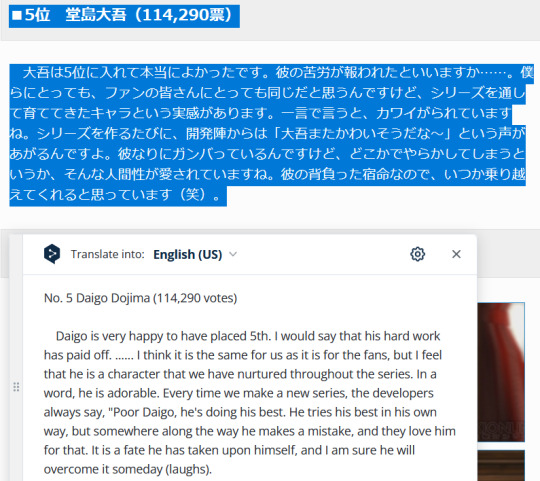
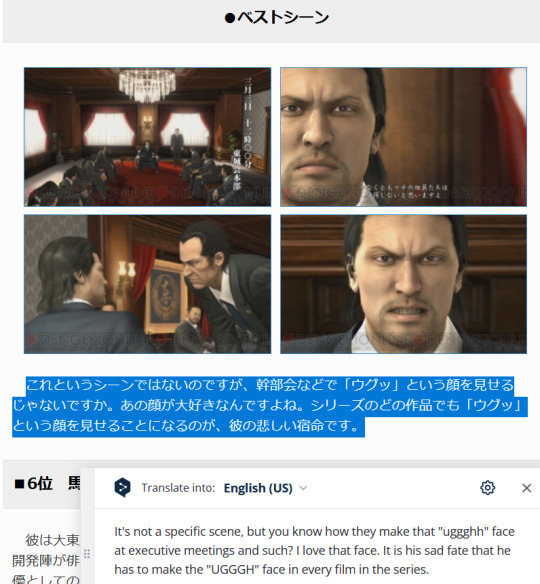
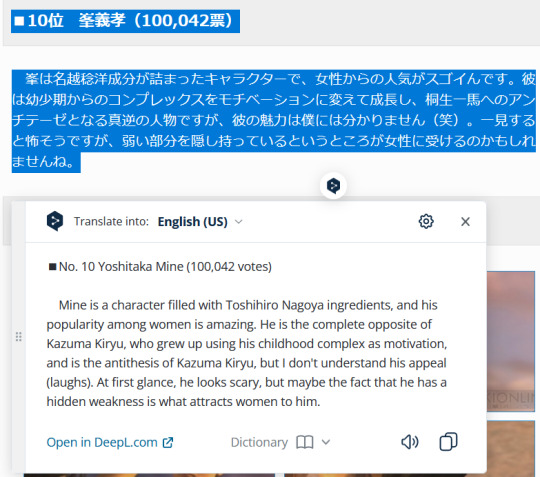
[baby note: 'Toshihiro Nagoya' is meant to be 'Toshiro Nagoshi' (名越稔洋), general director of RGG]

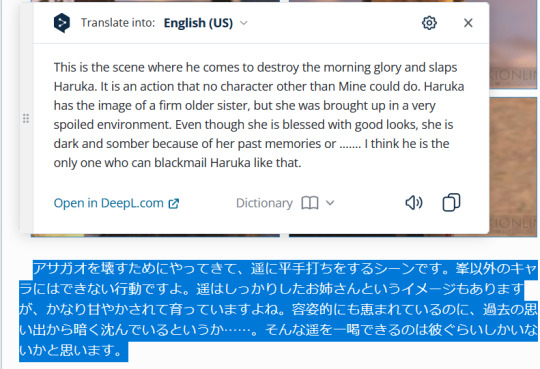
X
you WILL all deal with my shoddy translator its good enough at getting the point across mk the main point is vjflkJLKVJAERLJVEA
#long post#its important tho#snap chats#THATS SO FOUL VFLKAWRJVLERA#i repeat they are kinda spittin with callin daigo cute tho. like i get it i really do i feel it#love how yoko and the rest of rgg are surprised that most of their fans are women and queers when they make cute guys like daigo#'he's doing his best' thats literally the best way to describe daigos situation thats so goofy 💀💀💀💀#wow i love daigo .......#but naw the Best Scene bit for mine really being the orphanage is wack arJLKJERLGKJER
20 notes
·
View notes
Audio
Mitsuharu Fukuyama | Kiryu "Battle Theme" Yakuza: Dead Souls
#yakuza#ryo ga gotoku#kazama kiryu#yakuza dead souls#ryu ga gotoku of the end#sega#yakuza 4#龍が如#龍が如く OF THE END#mitsuharu fukuyama#toshiro nagoshi#goro majima#ryuji goda#shun akiyama
9 notes
·
View notes
Photo

The punk style of Toshiro Nagoshi, Corporate Design Director of Sega. Love that fabulous leopard coat!
Source: GIant Bomb
0 notes
Text
La serie Yakuza ya tiene su resumen hecho por el director ejecutivo
La serie #Yakuza ya tiene su resumen hecho por el director ejecutivo y ya está disponible para #Xbox One y #Playstation 4 Enterate de todo en Aporte Sur @XboxArg @PlayStation @RGGStudio

Desde hace unos días, la serie está disponible para PS4 y por primera vez Yakuza 0 puede jugarse en Xbox One con el Xbox Game Pass. Con estas novedades para la franquicia, el director ejecutivo de la serie, Toshiro Nagoshi, lanzó un video en el que da a los seguidores un pantallazo de la situación en que se encontraba Japón en 1980.
Una vez hecho esto, el autor del video profundiza en Yakuza 0,
View On WordPress
0 notes
Photo

Persona 5 Ships Over 1.8 Million Copies Worldwide
Persona has grown from a niche JRPG series to one of the biggest RPGs on the planet thanks to Persona 5. Those who need proof of this accomplishment need look no further than the statistics. During a Sega Raw livestream, Sega’s Toshiro Nagoshi announced that the game had shipped more than 1.8 million copies worldwide since it released on September 15 of last year.
Check it out!
http://www.hardcoregamer.com/2017/07/26/persona-5-ships-over-1-8-million-copies-worldwide/266222/
1 note
·
View note
Text
Confira o que rolou na Playstation LineUp Tour
Creditos site rkplay - http://bit.ly/2Nl18ig
A menos de duas semanas da Tokyo Game Show, é a época em que muitas empresas se apressam em confirmar presença no evento e/ou revelar seu line-up para a feira, com o intuito de atrair o público e promover seus títulos. A Sony resolveu fazer as coisas um pouco diferente, mas nem tanto. Conforme já havia sido previamente anunciado pela Sony Interactive Entertainment Japan , a conferência pré-TGS da empresa este ano será no formato Playstation LineUp Tour, um evento cujo foco é mostrar em vídeo jogos ainda não lançados para o PS4.
Com temática espacial, o evento ocorreu a portas fechadas, em um espaço relativamente pequeno com três telões, denunciando o foco em anúncios por vídeos. Além da imprensa, membros da PS Plus japonesa e alguns sortudos que possuem apenas a versão básica da PSN são sorteados para assistir ao evento de perto, ainda que o mesmo possa ser assistido online, numa transmissão ao vivo que acabou há pouco. Então embarque na nave Dualshock e visite diversos planetas, na forma de novidades que rolaram por lá.
A Cygames – empresa mais conhecida no mercado Mobile – abriu a conferência, mostrando mais do seu novo e ambicioso título, Project Awakening, que já havia dado as caras na E3 deste ano, com um novo trailer. Aqui vemos um guerreiro vagando por belos cenários e enfrentando montros no melhor estilo Monster Hunter. Project Awakening segue sem data de lançamento por enquanto.
[embedded content]
Em seguida foi a vez de Kingdom Hearts 3 trazer novidades, desta vez com a confirmação do elenco de Big Hero 6 no jogo e a compatibilidade com VR. Previsto para 25 de janeiro de 2019.
[embedded content]
A Square Enix também apresentou o Studio Istolia, nova divisão interna da publisher, que já chegou mostrando seu primeiro trabalho: Project Prelude, em um breve teaser, ainda sem data de lançamento ou maiores informações.
[embedded content]
A Square Enix, ainda anunciou o Remaster de Final Fantasy: Crystal Chronicles, previsto para chegar em 2019.
Fechando o bloco da Square Enix, tivemos ainda um novo trailer de Left Alive, jogo da série Front Mission, inicialmente anunciado para este ano, mas adiado para 28 de Fevereiro de 2019.
[embedded content]
Na sequência tivemos a Bandai Namco mostrando mais de God Eater 3, desta vez com data de lançamento. O jogo chega em 13 de Dezembro deste ano no Japão.
[embedded content]
No bloco de first parties da Sony, Days Gone, Ghost of Tsushima e Death Stranding receberam destaque, mas não trouxeram nenhuma novidade além do que já fora mostrado na E3 deste ano. Lembrando que Days Gone chega em 22 de Feveriro de 2019, já Ghost of Tsushima e Death Stranding ainda não possuem data de lançamento. Resident Evil 2 Remake também deu as caras na conferência, mas assim como os três títulos já mencionados, não mostrou nada de novo, apenas o mesmo trailer da E3. O jogo chega em 25 de Janeiro de 2019.
Koei Tecmo e Team Ninja mostraram mais de Dead or Alive 6 e revelaram, enfim, a data de lançamento do jogo de luta: 15 de Fevereiro de 2019.
[embedded content]
Ainda nos jogos de luta, desta vez foi a SNK que mostrou seu – não tão – mais novo título: a série Samurai Shodown (Samurai Spirits) voltou à vida com um novo jogo, completamente reformulado com belos visuais. O jogo está previsto para 2019, mas sem data de lançamento.
[embedded content]
Quebrando um pouco o ritmo do foco no telão, Toshiro Nagoshi, produtor da série Yakuza, subiu ao modesto palco para apresentar uma nova IP da SEGA: Judge Eyes. No mesmo estilo de Yakuza, o jogo tem como foco resolver mistérios e investigar crimes, e chama a atenção pelo realismo nas feições dos personagens. O jogo está previsto para chegar ainda este ano, em 13 de Dezembro no Japão, e em 2019 no ocidente. A demo estará disponível durante a TGS.
[embedded content]
A From Software não poderia ficar de fora, e retomando o foco aos vídeos, mandou logo um novo trailer de Sekiro: Shadows Die Twice, mesclando história e gameplay. O novo título da From Software com a Activision chega em 22 de Março de 2019.
[embedded content]
O estúdio Iggymob mostrou um teaser de Gungrave G.O.R.E, novo título da franquia, com previsão para chegar no inverno (hemisfério norte) de 2019, provavelmente entre janeiro e fevereiro.
[embedded content]
No bloco VR, destaques para a experiência participar de combates aéreos em Ace Combat 7: Skies Unknown e para a proposta ainda não muito clara de Deraciné. Enquanto o primeiro jogo deve – enfim – chegar em 18 de Janeiro de 2019, o título da From Software segue sem data definida, mas está previsto para este ano.
Para fechar a conferência, vários títulos de empresas third parties ganharam os telões do evento, dentre os quais estão: Red Dead Redemption 2 (Rockstar/2K), One Piece: World Seeker (Bandai Namco), Anthem (Bioware/EA), Fallout 76 (Bethesda), The Division 2 (Ubisoft), Devil May Cry 5 (Capcom) e Jump Force (Bandai Namco).
E foi isso que rolou na Playstation LineUp Tour, a pré-conferência da Sony antes da TGS deste ano. Mais detalhes e, quem sabe, novidades, saberemos na feira. A Tokyo Game Show ocorre entre os dias 20 e 23 de Setembro, na capital japonesa.
Creditos , Meia lua- link original http://bit.ly/2CA9IWm
O post Confira o que rolou na Playstation LineUp Tour apareceu primeiro em Rk Play - Canal de video games.
from WordPress https://rkplay.com.br/index.php/2018/09/10/confira-o-que-rolou-na-playstation-lineup-tour/
0 notes
Text
thesingingemma
replied to your post
“Me, hours upon hours of playing the Yakuza games : Nothing can...”
That.. thing.. was fucking scary.
Stuff of NIGHTMARES. Nagoshi Toshiro I have questions and I demand answers.
#thesingingemma#return to shangri-la they said#it would be FUN they said#why was he there#how does he survived there#why the eye#why that outfit#how and when??#but most importantly WHY??#ryu ga gotoku#yakuza
0 notes
Text
Nintendo Switch: hybrid games console to launch on 3 March
Japanese gaming company reveals new console, which launches with flagship title Zelda: Breath of the Wild, will cost $299.99 in US and 279.99 in UK
Japanese gaming company Nintendo has unveiled its new Nintendo Switch console at a presentation in Tokyo.
The device, a hybrid that can be used both handheld and with a TV when in a dock, will go on sale on 3 March priced $299.99 in the US and 279.99 in the UK. Other European prices will vary, Nintendo said.
The pricing is higher than had been rumoured and makes the Switch more expensive than rivals Sonys PlayStation 4 and Microsofts Xbox One S.
The new gaming platform wants to do everything at once, executives said, from the old-school fantasy of its flagship launch title, Zelda: Breath of the Wild, to party games played face-to-face rather than in front of a screen.
The Switch inherited all of Nintendos entertainment DNA across the companys broad line of products, said Shinya Takahashi, Nintendos head of software development.
The presentation, which was streamed live, ended with a surprise revelation: the long-delayed Breath of the Wild, originally planned as an exclusive to the Wii U platform, will go on sale with the new console.
The first Mario game for the platform will not debut until later in the year: Super Mario Odyssey, a large Mario sandbox world, in the words of producer Yoshiaki Koizumi, will exile Mario to an unknown world our own. Footage from the game shown at the presentation featured Mario leaping through realistic forests and over yellow taxi cabs. Koizumi also produced the Mario Galaxy franchise for the company.
And Nintendo may be mending fences with third-party developers: Electronic Arts executive Patrick Soderland said the game companys wildly popular Fifa football franchise would return to the Switch after years of refusing to make versions of its games for the Wii U. The hugely popular building game Minecraft will also be coming to the Switch, its makers confirmed
Nintendo is also rolling back its digital rights-management protections slightly: the company will not region-lock its games, Kimishima told the audience, meaning that Switch games will be playable whether or not they were purchased in the same country as the console itself.
The company merged its living-room console and handheld device divisions to create the Switch: the machine has a built-in screen so it can function as a tablet-sized handheld gaming device, but it also plugs into a dock attached to a television. Its single complex controller splits into two simpler controllers for in-person multiplayer.
Nintendo has doubled down on its non-standard hardware design largely in the service of keeping users off the couch. Kouichi Kawamoto, general hardware director for Nintendo, introduced a game called 1, 2 Switch similar to the simple, sometimes acrobatic Wii Sports games that came with the companys original Wii system. Players quick-draw their controllers like gunslingers in a western or battle with swords, among other activities. 1, 2 Switch isnt a game you play facing the screen, it is a game that is primarily played through face-to-face interaction, Kawamoto said. The executive suggested bringing the game to parties and called it an icebreaker for all kinds of fun communication.
A new online multiplayer service debuts with the Switch, but like competitors Sony and Xbox, Nintendos service will be subscriber-only by the end of the year, with a grace period of a few months for early adopters.
Among other new game announcements:
Nintendo will make a sequel to its Wii U paint-gun game Splatoon for the Switch
Along the lines of popular 1980s title Punch-Out, Nintendo will release Arms, a boxing game starring creatures with long springs for arms, playable online against other Switchers
The presentation solved a second missing-games case: Xenoblade Chronicles 2, the long-rumored and now-confirmed sequel to the popular 2010 Wii action-RPG, will debut on the Switch
Eccentric developer Suda51 did not quite say a new No More Heroes game was on its way, but he did say Travis Touchdown is coming to the Nintendo Switch.
Toshiro Nagoshi of one-time Nintendo nemesis Sega said his company will consider new games for the Nintendo Switch and present them soon.
Is Nintendos Switch hybrid console the future of gaming?
Read more: http://bit.ly/2jDGibH
from Nintendo Switch: hybrid games console to launch on 3 March
0 notes
Text
Creartive Officer of SEGA Talks About Next Generation Platforms
Polygon has recently had a talk with Toshiro Nagoshi, chief creative officer at SEGA about next generation consoles. He says that SONY and Microsoft are "going to wage an all-out war" while Nintendo is trying to differentiate themselves. “They’ll be better-performing systems, but I think they’ll start being closer and closer to each other on the inside. The Wii and Wii U are differentiating themselves on the hardware level, but the other two systems are going to wage an all-out war of services, one that’ll involve the entire Sony group and the entire Microsoft group. It’ll be a battle to see which group can leverage its scale to best benefit developers and gamers.”
0 notes
Video
youtube
The intention of putting out a video about “The Future of Sega” is immediately clear. They are going to put the viewer at game conventions and on Internet video sites on notice that the company is trying to make a comeback, and to watch out for them.
A certain way of looking at Sega after they dropped out of making video game consoles is that they’ve had a steady drop in quality, and have become a virtual Nintendo subsidiary at the point children’s games and the nostalgic retro market converge. In short, the old days of punk rock provocation to appeal to counter-cultural sensibilities are over. This view tends to look most tenable in North America, as many of the high-quality games with this kind of cool appeal since the end of the Dreamcast in 2001 were made with a Japanese market in mind, and have had limited or nonexistent releases in America. To play anything from Jet Set Radio Future to Hatsune Miku: Project DIVA Future Tone to Persona 5, it becomes clear a lot of what was cool about Sega is still being made. Assuming we’re able to play it too.
Still, Blake J. Harris’ Console Wars: Sega, Nintendo, and the Battle that Defined a Generation makes the argument that one of the major reasons for the precipitous decline in fortunes for the company after gaining majority shares in the American console market was the jealousy of Sega of Japan for Sega of America. Japanese employees were often reprimanded for why they couldn’t match the successes of their American subsidiary. So in the development and launch of the Sega Saturn, Sega of Japan was ill-inclined to take input from Sega of America, particularly in terms of a proposed collaboration with Sony. And then they made sufficiently many bad decisions on their own that they couldn’t compete with the Sony Playstation.
The subtext of American exceptionalism in Harris’ writing isn’t terribly subtle. But the fact remains that the Saturn didn’t have enough of the kinds of games that appealed to wider sections of the American public. This was compounded in terms of games like Tomb Raider being developed for the Sega Saturn, but becoming a major hit on the more widely owned Sony Playstation. A similar argument can be made of the reversal of the Sega Dreamcast from an extraordinarily successful launch to an abrupt crash. As much as I love bonding over discussion of the gonzo experiences afforded by the eccentric games on the Dreamcast, the uninitiated tend to regard it like that decade-old meme:
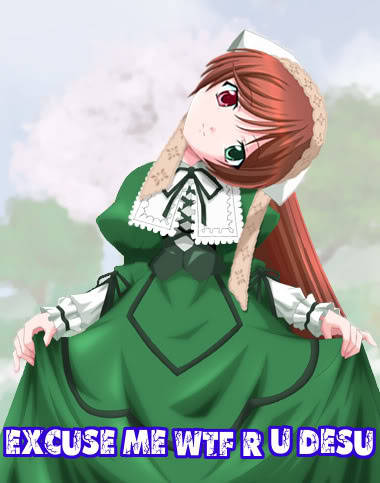
In terms of these quandaries, Sega has spent much effort in 2017 in a rebranding to attract the attention of anyone with fond nostalgia for their output back to the company. So far, this has met both successes and failures. The release of Sonic Mania and Sonic Forces for the 25th anniversary of the release of Sonic the Hedgehog has seen the former game borne of the international collaboration between the Japanese Sonic Team and the American fangame developers Headcannon become a renowned success. It has also seen the humiliation of the latter game, intended to be main showing with far more production value, being upstaged by a clever remixing of 16-bit sprites and receiving mixed reviews instead.
Sega has launched the “Sega Forever” project porting what is to be classic games on all their consoles to mobile devices, but has received criticism for a greater number of glitches than those whom have played ports on other consoles. Which is to say, quality control wasn’t up to par. At this point in time, Sega has adopted the rebranding of “Amazing Sega” in Japan, which amounts to a declaration of what reaction they want their games to elicit. A declaration of commitment to awe-inspiring quality. These things contexualize the public relations video “The Future of Sega”.
The opening shot is of an eye whose movements are biometrically measured by a computer. Fans of sci-fi cinema might recall that Ridley Scott’s 1982 cyberpunk film Blade Runner features an extreme close-up of an eye in its opening as a reference to George Orwell’s 1984 with its surveillance society of two-way media sending messages and receiving information. The same film features the “Voight-Kampff Test” tracking pupil dilation and eye movements as subjects are interrogated with a series of questions testing their capacity for empathy, and thus whether they are to be understood by American society as humans or android “Replicants”. This visual in Sega’s ad, combined with the technological white-out effect on the eye, appears disconcerting, a kind of technological “brave new world” of the viewer might wonder how they will get on in.
After the Sega logo appears signaling a major point of continuity between Sega games, we are introduced to the silhouette of “Toshiro Nagoshi/SEGA Games CO., Ltd./Corporate Director/Chief Product Officer/Entertainment Content Group” typing at his computer in a domestic high-rise setting, probably in Tokyo. When the camera moves in to a close-up, we are certainly not greeted with the image of a conventional Japanese salaryman. This guy is more edgy, more like a character in an East Asian gangster movie surrounding the Yakuza. In photographs, he often wears punk stylings like leather and leopard jackets, but here he’s going by the image of a way of doing business on the margins. Respectability in a conventional sense doesn’t necessarily get what people want, so Sega’s going to pursue a kind of maverick outlaw gaming approach. Nagoshi is in fact creative director on Sega’s Yakuza series; extraordinarily successful in Asia, and virtually unknown in North America.
An immediate encounter with this macho fellow might provoke fears of the kind of ass-kicking dispensed in his flagship series. But in his voice-over, he queries “When is a person moved? When they’re filled with joy? When their heart skips a beat?” The recurring problems of the finer points in English grammar when translated from Japanese are visible here. But the point remains that he’s motivated not in terms of leaving us bruised and sobbing by the side of the road, but by the means of understanding human happiness.
Nagoshi’s travels around the city where children and adults alike experience interaction design on their mobile devices have convinced him that these things have to do with “Experiencing the unprecedented.” The use of montage reassures viewers that Japanese favorites like Sonic the Hedgehog, Yakuza, and Puyo Puyo will still be kept in mind and made more accessible on these devices. Young women will still delight at capturing Sonic the Hedgehog plushies at a local Sega Game Center. But they’re going to be the kind of company that innovates and produces games that immerse the player into the protagonist. Perhaps more edgy games too, not just playing it safe with the once inconceivable alliance with Nintendo and their “family values” mentality.
Returning to the motif of the eyes at the beginning, Nagoshi says that compared to other animals, humans rely on their eyes more than other sense organs. Consequently, the eyes register a greater range of expression of emotion regarding an experience, including the telltale signs of amazement. On this principle, Sega has taken to the application of biometric technologies on test players to register their emotional responses at each moment, and take that data into consideration in the development process. Indeed, a viable argument for how they can create more fun and engaging games.
But stated another way, this means that video game companies, and tech companies that apply principles of “gamification” to interaction design, have greater insight into how to manipulate our emotions than ever before. Perhaps one major difference between the conception of dystopia in the 20th century and that of the 21st century is that it is now readily conceivable that such a state need not make the people who live in it miserable, indeed can make them highly engaged in a state that’s terrible underneath the perception of the media environment. Timothy Snyder’s book On Tyranny: Twenty Lessons from the Twentieth Century reminds us of the “interactive television” in Fahrenheit 451 and “two-way” TV in 1984 while books are banned in both cases, proving too fixed compared to the plastic memories of New Media and the revisionist needs of propaganda machines (p. 84). The technologies of video games systems connected to the Internet and picking up a greater or lesser amount of data from users have a great deal to do with that state of affairs. But for now, Sega sets out to create better video games in a world often resembling that of the antagonists in their past narratives, sending out certain messages with greater or lesser degrees of courage in this context. Ultimately, the Sega logo is shown imprinted upon the human eye in the extreme close-up of the final shot.
One important thing to take note is the Japanocentric nature of this vision for the company as presented in this advertisement. The ads Sega has shown these days in America have a great deal to do with nostalgia for the past made accessible on current technologies. But in terms of the vision for Sega’s future, they largely opt to show titles extraordinarily popular in Japan and virtually unknown in America. The focus is on the ways Sega has embedded themselves successfully as a brand and a presence in Japanese society, with little to say about an international orientation. While Americans are also shown this video translated into English, there’s a definite subtext that we’re an afterthought in Sega’s plans who may or may not receive localizations of their games, as has often been the case hitherto.
0 notes